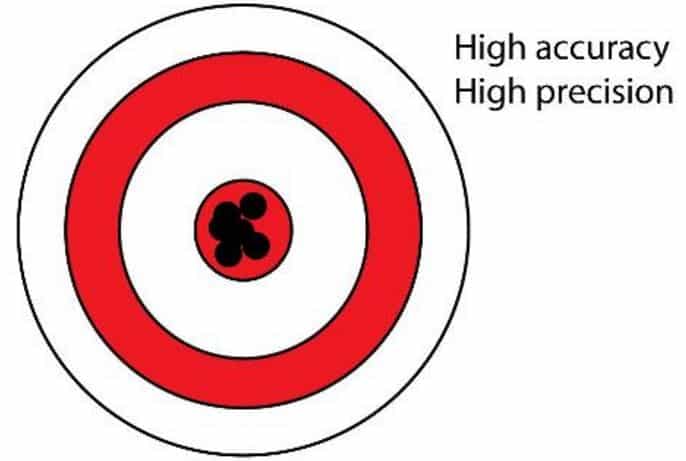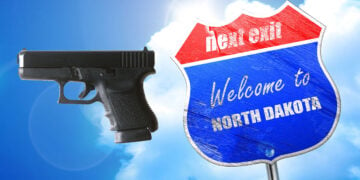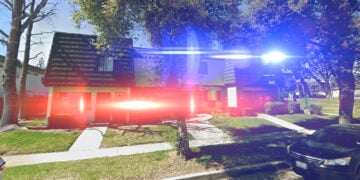There seems to be some misinformation, hearsay, misinterpretation, and a lot of misunderstanding about sight radius and its relationship to accuracy and precision. So I want to define the terms, explore them, and draw some conclusions based on my opinions about these three factors for defensive shooting. Understand that this is not pure scientific research and I did not use a Ransom Rest and strive for 1 inch groups, etc., but merely did my informal data gathering, subjective analysis, and formed my opinions and conclusions about them. This may just help save my live, the lives of others, and get you thinking about the topic for your benefit.
Sight Radius Definition
To begin, I want to have a basic definition of sight radius. While not a major epiphany, sight radius is merely the distance between the back of the front sight to the back of the rear sight of a gun’s iron sights. The closer the distance between the sights, the shorter and smaller the sight radius. So, generally, the larger the gun and longer the barrel, the longer the sight radius. An AK-47 and AR-15 will have a longer sight radius that a full-size pistol, which has a longer sight radius than a snub-nosed revolver or subcompact pocket pistol.
So what does it matter about the sight radius? Is this such a big deal? Should we even be concerned about the distance between the sights? Well, yes. For one thing sight radius affects your gun’s sight height and point of impact for your hits on target. For example, if your pistol with a sight radius of 5.5″ has hits on target that are 2″ low from a distance of 15 yards, then you need to shorten your front sight by a certain amount (as one option.)
The simple calculation using sight radius to determine how much front sight height change needed is:
Sight Radius x Impact Distance Error / Target Distance = Front Sight Height Change
EXAMPLE: Sight Radius 5.5″ x 2″ Low = 11 / 540″ Distance = .0203 ” Shorten Front Sight
- Does it really directly and significantly affect accuracy and/or precision?
- Are there more important factors to focus on for effective shooting?
- What about the basic fundamentals of shooting like trigger control, sight alignment, sight picture, follow through, movement control, etc.?
- Are these fundamentals much more important than sight radius and should they be our priority?
- What role does the specific gun itself play and its features, quality construction, ergonomics, type of sights, and capabilities, etc.?
- Is there a relationship among all these factors, including the sight radius distance, the fundamentals, the gun itself, the ammo used, and what specific purpose you are using the gun for?
A lot of folks believe pretty strongly about the value or lack of value of sight radius. Well, I want to address these things with my opinions. I do not believe there is even close to universal agreement on sight radius considerations and conclusive results. I’ll be anxious to learn your sight radius opinions and comments in the section below this article.
Accuracy is Not Precision
Being accurate and precise are important to shooters and hits on target. Often they are incorrectly used synonymously to mean the same thing, but there is a technical difference. For example, will a pistol with a 6-inch barrel and long sight radius be more accurate or precise at a long distance than a pistol with a 3-inch barrel and a short sight radius at a very close distance? Accuracy and precision are key whether defending your live in a close-up deadly-force encounter or shooting 100-yard bullseyes. But, let me define and differentiate between them. I will not include an individual’s’ gun-handling and personal shooting proficiency skills to define accuracy and precision, rather focusing on the gun’s characteristics and hits on target. But this is not meant to minimize the importance and effects of a shooter’s skills and contributions to them, since most contemporary handguns are more accurate than the shooter.
Briefly, accuracy is a measurement of the shooter’s gun performance and his/her ability to consistently hit a given target. Is the shooter’s group of hits centered on the bullseye or desired target point of impact. Precision is essentially the tightness or size of the shooter’s groups, no matter where they are located on the target itself. They are NOT the same concept. So, it is possible to be precise and not accurate, just as it is possible to be accurate and not precise. Often a gun that consistently produces tight groups is described as “Accurate,” it is best described as having “Precise” hits. Here are some examples to differentiate between accuracy and precision.

High Accuracy: Shots in or very near bullseye.
Low Precision: Shots are NOT grouped close together & are scattered across target.

Low Accuracy: Shots NOT in or very near bullseye.
High Precision: Shots are grouped close together & are NOT scattered across target.

Low Accuracy: Shots NOT in or very near bullseye.
Low Precision: Shots are NOT grouped close together & are scattered across target.

High Accuracy: Shots in or very near bullseye.
High Precision: Shots are grouped close together & are NOT scattered across target.
Most new shooters and non-shooters use the term “Accuracy” when they really probably mean “Precision.” They usually use the word accurate and intend to indicate the ability to hit the target someplace, rather than to shoot a small group. A defensive shooter is usually concerned more with hitting the attacker target and stopping the threat, than having all shots hit in the exact same place precisely on the attacker. Some indicate that the defender probably does NOT want all shots to hit the attacker in the very same precise location (a small group) because more damage may be done initially to stop the threat with “accurate” hits someplace on various key body locations. Understand this varies by goal and situation.
Accept and understand that accuracy and precision are closely related. Recognize that accuracy is a measure of the shooter’s ability to cause the group to hit the target, by adjusting the point of aim. Competitive shooting and bullseye shooting usually place more attention on precision and shooting small groups. Usually, a high degree of accuracy is almost impossible without precision and attention to key fundamentals. To accurately hit the target, a shooter must adjust the aim to account for several key fundamentals, conditions, sights, gun and ammo factors.
What about sight radius and self-defense?
So, does sight radius matter in defensive shooting? Over the years, I have been trained and learned that outside of very close-up conversational distances, sight radius does indeed matter, including for most self-defense shootings. At some very close distances, the shooter may not even use the sights and even fire from the hip to stop the attacker who is just two feet away, negating the sight radius and precision concerns. But, a caution, do not let sight radius be the only or even the major factor in selecting your carry gun. Just because any particular gun, e.g. pocket pistol, has a short sight radius does not mean the gun is not accurate, but rather it is harder for the shooter to be accurate with it. Why? More considerations to follow below.
So for myself personally, I have gravitated toward about 3.5 to 4-inch compact barrels, even up to 5″, and their sight radiuses for self defense and concealed carry. This is not to the exclusion though of 3-inch subcompact pocket pistols and their shorter sight radius. I rotate among several carry guns depending on my attire, weather, activity (e.g. sports v. casual lawn mowing), weight at the time, and other factors. Even for the same/similar barrel lengths, sight radius vary some. I may carry the following:
- FNS-9 Compact with 3.6″ barrel and its 5.6″ sight radius
- Springfield EMP 3″ (4.5″ sight radius)
- EMP 4″ barrel with a longer 5.5″ sight radius
- Ruger SR9-C and its 3.5″ barrel (5.5″ sight radius)
- Sig 320C (6.6″ sight radius)
- S&W M&P 9C (5.7″ sight radius)
- S&W Shield (5.3″ sight radius)
- Sig 938 (4.2″ sight radius)
- Kimber Micro 9 (4.3″ sight radius)
- Glock 19 (5.9″ sight radius)
- Ruger LC9S (4.5 sight radius)
But, decide for yourself.
Some Sight Radius Considerations
While I believe that sight radius, a quality gun, and quality ammo/equipment are certainly important, to me getting the proper training, giving attention to the fundamentals of shooting, especially trigger control, and regular and proper practice are the real keys.
Of course, your eyesight is a major influencing factor and I have old codger eyes. I did a small, informal unscientific experiment among some of my guns from major manufacturers, with various sight radiuses. I found for me and my average skill level (with my impaired older vision and with quality guns and ammo involved), although there was a correlation or a strength, linear relationship among the various sight radiuses, accuracies, and precisions, there was not a significant direct cause and effect association between sight radius and accuracy or precision at shooting distances less than 15-20 yards. I started noticing a difference at about 20 yards and farther, with a longer sight radius getting slightly better accuracy and precise target hits at a longer distance.
This may be different for you, your skill set, gun, sights, ammo, equipment, vision, etc. But, I believe sight radius DOES matter, especially at longer distances. However, for me, trigger control and sight picture were the major (not only) considerations, after proper sight alignment.
I concluded for myself for most of the time that the greater the distance the better my accuracy and precision was using a gun with a longer barrel and longer sight radius. It is not that a longer sight radius gives you better accuracy, but that it’s just easier to be accurate because you see the movement better.
I partially explained this to myself by the fact that when there is a longer shooting distance involved and with a long sight radius and barrel, given my natural body movements (we all move some) and eye flinches, the front sight, gun, and body movements are more noticeable to me and I can correct them for improved accuracy and precision. Although, I seemed to align my sights QUICKER with a shorter sight radius. I suppose by being able to easier see and adjust for those slight deviations with a longer sight radius and barrel, your shots are going to be more accurate and/or precise.
As a layman gunsmith with little experience, I understand that when a long sight radius is accompanied by a similarly long barrel, the bullet will usually be more stable and travel faster for hitting the target, due to the momentum buildup and time inside the barrel. And, it’s just easier to be more accurate and precise, since you can see the movement and then adjust.
Another interesting observation is that the farther my front sight focal point was from my eye, with the various sight radiuses and barrel lengths, the clearer (but still blurred) the usually blurred target in the background became. With a longer sight radius and my particular eyesight, I had a clearer view most of the time of the front sight and a better view of the expected and still fuzzy target. Maybe the shorter the distance relationship between the front and rear sights, the harder your eyes must work to get the accuracy and precision.
On the other hand, some may shoot better with a pistol that has a shorter sight radius depending upon their vision, e.g. some aging eyes may see the close front sight better on a smaller gun that has a short sight radius. Also, it seems for me with a shorter sight radius, imperfections in the sight picture are not as noticeable. Maybe this red dot movement for defensive pistols is something to take seriously, since you must find the dot and focus on the target. See my previous reviews on this website about some great red-dot gun packages. So generally a longer sight radius helps to make it easier to line up your sights with precision and a shorter sight radius makes it easier to line up your sights quickly. It may not necessarily make you more accurate or more precise. Remember, the consideration that the longer barreled guns with longer sight radis’ give a longer length of travel for the bullet within the barrel. This affects terminal performance and helps realize higher velocities from the longer barrel travel. This can be a critical factor for stopping a threat.
Well I hope my thoughts here, experiences, and opinions have not confused or frustrated you, but rather served as a springboard for you to think about these factors and the relationships among sight radius, accuracy, and precision for yourself. While there are no universal conclusions about these variables, they are important ones to ponder and to decide how you will individually address them, according to your own set of skills, guns, ammo, sights, equipment, medical conditions, distances, eyesight, etc. I wish you Continued Success!
What are your thoughts about the relationship among sight radius, accuracy, precision, and other shooting factors?
Photo by Author.
* This personal opinion article is meant for general information & educational purposes only and the author strongly recommends that you seek counsel from an attorney for legal advice and your own personal certified weapons trainer for proper guidance about shooting & using YOUR firearms, self-defense and concealed carry. It should not be relied upon as accurate for all shooters & the author assumes no responsibility for anyone’s use of the information and shall not be liable for any improper or incorrect use of the information or any damages or injuries incurred whatsoever.
© 2017 Col Benjamin Findley. All Rights Reserved. This article may not be reprinted or reproduced in whole or in part by mechanical means, photocopying, electronic reproduction, scanning, or any other means without prior written permission. or copyright information, contact Col Ben Findley at [email protected].



![CZ P-10 Compact 9mm [FIREARM REVIEW]](https://www.usacarry.com/wp-content/uploads/2017/07/CZ-P-10-C-9mm-Review-75x75.jpg)





